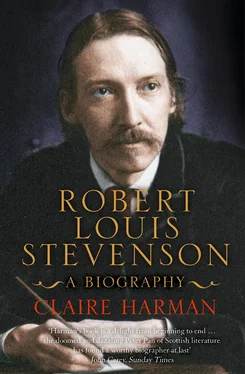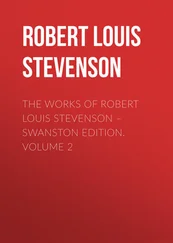The Master of Ballantrae , ‘Markheim’,
Deacon Brodie, Catriona ; he even introduced the theme into a topographical study of Edinburgh. He was a bilingual writer, too, in Scots and English, and ‘double-handed’, ambidextrous. Doubleness is central to his very theory of composition, as set out in his essay ‘A Chapter on Dreams’, where he claims that the inventive side of his writing was beyond his conscious control. He was fascinated by the uneven surface of ‘the self’, its endless ability to surprise the conscious man. In a letter of 1892 to F.W.H. Myers, one of the founders of the Society for Psychical Research (of which Stevenson was a member), Stevenson recalled various times in his life as an invalid when high fever had made him aware of having ‘two consciousnesses’. He characterised these as
Myself and
the other fellow ; the latter irrational and absurd, the former, his right mind, painfully aware of its temporary subordination. It wasn’t the conflict between them that interested him so much as his awareness of their co-existence, at once scientific and poetic. More than any other nineteenth-century writer he might have said, along with his admired Walt Whitman, ‘I am large, I contain multitudes’.
Stevenson was an ironist and iconoclast, an admirer of Herbert Spencer, Darwin, Thoreau and Whitman and an influential thinker in his own right, much more than is recognised. His essays addressed the urgent scientific, moral and aesthetic questions of the day and his novels and stories dramatised them. He was one of the least ‘Victorian’ of all Victorian writers. As a young man, he longed to emulate the style and substance of the three-decker novel, but in fact he became part of the movement which supplanted that model, a prototype modern man of letters. His interest in psychology anticipated the concerns of the next century, his confessional tone was tuned to it, even the forms he liked best – those of short story and novella – have been more popular in our own day than in his. Writers as diverse as Graham Greene, Cesare Pavese, Italo Calvino, Vladimir Nabokov and Jorge Luis Borges have revered him as a master (it is said that Borges kept his collection of Stevenson’s works separate from all others on his bookshelves), and generations of readers have delighted in his wonderful powers of invention. It is this multitudinous character, inconsistent, original and constantly surprising, whom I wish to present.
Born 1850 at Edinburgh. Pure Scotch blood; descended from the Scotch Lighthouse Engineers, three generations. Himself educated for the family profession … But the marrow of the family was worked out, and he declined into the man of letters.
Robert Louis Stevenson, ‘Autobiographical Note’ 1
IN 1884 OR THEREABOUTS, Robert Louis Stevenson purchased a copy of a slim booklet by the scientist Francis Galton (grandson of Erasmus Darwin and inventor of the term ‘eugenics’), that purported to help members of the public forecast the mental and physical faculties of their children by arranging in tabular form as much data as could be gathered about their ancestors. No clear way of making deductions from this process was indicated; Galton seemed merely to be suggesting that the Record of Family Faculties would serve as a sort of life album for future perusal. In fact his design was more ‘to further the science of heredity’ than to enlighten individuals about their genes, for Galton was offering a prize of £500 to whichever reader compiled ‘the best extracts’ from the point of view of ‘completeness’, ‘character of evidence’, ‘cleanness’ and ‘conciseness’, to be sent, with accompanying documentation if possible, to his London address.
Robert Louis Stevenson did not oblige the insatiable statistician by posting off his copy of the booklet, and only filled in two pages of information, one for each of his parents. Like so many of his own books, this was one he couldn’t quite finish. But Galton’s introductory remarks, full of provocative assumptions about race, personality, inherited and acquired behaviour, touched subjects of perennial fascination to the scientist-turned-literary man. ‘We do not yet know whether any given group of different faculties which may converge by inheritance upon the same family will blend, neutralise, or intensify one another,’ Galton had written, ‘nor whether they will be metamorphosed and issue in some new form.’ The year in which the project was advertised, 1883, was a time when Stevenson himself thought he was going to be a father, an eventuality he had tried to avoid on the grounds of his poor health. But whether or not Stevenson bought Galton’s book in order to predict his expected child’s chances in the lottery of family attributes, the author’s words certainly resonated for himself.
Robert Louis Stevenson characterised his paternal ancestors as ‘a family of engineers’, which they were for the two generations preceding his own, but in the seventeenth century they had been farmers and maltsters near Glasgow, ‘following honest trades [ … ], playing the character parts in the Waverley Novels with propriety, if without distinction’, as Stevenson wrote satirically. 2 In the mid-eighteenth century two Stevenson brothers, working in partnership as traders between Glasgow and the West Indies, both died suddenly from tropical fever within six weeks of each other while in pursuit of an agent who had cheated them. Jean, the twenty-three-year-old widow of the younger brother, was left almost destitute by his death, as her father also died in the same month and she had an infant son to support. Her second marriage, to a man called Hogg, produced two more sons but ended in desertion and divorce. By this time, Jean was living in Edinburgh and there met and married her third husband, a ship-owner, ironmonger and underwriter called Thomas Smith.
Smith was the founder of the ‘family of engineers’, or rather, the step-family, since it was his new wife’s teenaged son Robert Stevenson, not his own son, James Smith, who was grafted onto his thriving enterprise as heir. Thomas Smith seems to have been a man of enormous industry and ingenuity, setting up a business in lamps and oils, running something called the Greenside Company’s Works in Edinburgh (a kind of super-smithy) and inventing a new system of oil lamps for lighthouses to replace the old coal-lit beacons like that on the Isle of May. The lights of ‘lights’ remained a source of fascination in the step-branch of the family: Robert Stevenson experimented with revolving devices, his son Thomas developed both holophotal and condensing lights, and Robert Louis Stevenson’s one and only contribution to the Royal Scottish Society of Arts was a paper on a proposed new device to make lighthouse lights flash. But there was another reminder of this heritage, closer to home. One of Thomas Smith’s lamp-making projects was the design of the street lighting in Edinburgh’s New Town at the end of the eighteenth century. His parabolic reflector system quadrupled the power of oil-lit lamps and focused their beams, a revolutionary innovation that must have made the elegant Georgian streets look even more modern and sleek, even more of a contrast to the dark, narrow closes and wynds of the Old Town. And it was the successor to one of these lamps, just outside 17 Heriot Row, that Robert Louis Stevenson celebrated many years later in his poem about Leerie the Lamp-Lighter from A Child’s Garden of Verses :
For we are very lucky, with a lamp before the door,
And Leerie stops to light it as he lights so many more;
And O! before you hurry by with ladder and with light,
O Leerie, see a little child and nod to him tonight!3
Читать дальше












